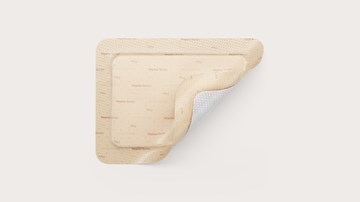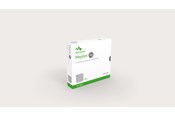Apósito antimicrobiano de espuma
Mepilex Ag
Apósito antimicrobiano de espuma para quemaduras y heridas con niveles de exudado de bajo a moderado
Mepilex® Ag es nuestro apósito antimicrobiano de espuma más versátil para cuando necesite reducir el grado de contaminación microbiana de la herida. Está diseñado para quemaduras y heridas con niveles de exudado de bajo a moderado. Puede utilizarlo para úlceras del pie diabético o de la pierna, úlceras por presión y quemaduras de espesor parcial.
Tal y como se ha demostrado «in vitro», este apósito de espuma inactiva los patógenos relacionados con la herida (bacterias y virus) en los primeros 30 minutos
Mepilex Ag se adhiere suavemente gracias a Safetac® la capa de contacto original con silicona que minimiza el dolor. Para cambios de apósitos atraumáticos
- Atraumático durante los cambios de apósito
- - Actividad antimicrobiana rápida y sostenida
- Clínicamente probado en estudios comparativos para acelerar el tiempo de cicatrización en pacientes con quemaduras de espesor parcial
- Clínicamente probado para reducir costes debidos al cuidado de pacientes con quemaduras de espesor parcial
- Clínicamente probado en la reducción del dolor y de la ansiedad de pacientes con quemaduras de espesor parcial
Más información sobre el producto
Cuándo utilizar Mepilex Ag
Puede utilizar Mepilex Ag para heridas con niveles de exudado de bajo a moderado, como úlceras del pie diabético o de la pierna, úlceras por presión y quemaduras de espesor parcial. Además, también puede combinarse con vendaje compresivo. Mepilex Ag puede usarse en heridas infectadas como parte de un tratamiento bajo la supervisión de profesionales sanitarios cualificados.
Cómo utilizar Mepilex Ag
Empiece limpiando la herida antes de aplicar el apósito. Para conseguir el mejor resultado, Mepilex Ag debe cubrir la piel perilesional seca al menos entre 1 y 2 cm en caso de tamaños pequeños (hasta 12,5 x 12,5 cm) y 5 cm en caso de tamaños grandes para proteger la piel perilesional frente a la maceración, además de fijar el apósito de forma segura. Utilice Tubifast® cuando necesite fijación.
Nota: Para conocer todas las instrucciones de uso, vea el prospecto del envase.
Mepilex Ag – Cómo funciona el sulfato de plata contra los microbios
Vea cómo las partículas de sulfato de plata impregnadas en los apósitos Mepilex Ag crean un efecto antimicrobiano en los microorganismos.
Datos del producto
| Ref. | Tamaño (cm) | Unids/Env. | Unidades/TRP |
| 287110 | 10 x 10 | 5 | 70 |
| 287310 | 15 x 15 | 5 | 25 |
| 287410 | 20 x 20 | 5 | 20 |
| 287510 | 20 x 50 | 2 | 12 |
Productos relacionados
'References'

 Apósito antimicrobiano de espuma Mepilex Ag
Apósito antimicrobiano de espuma Mepilex Ag












